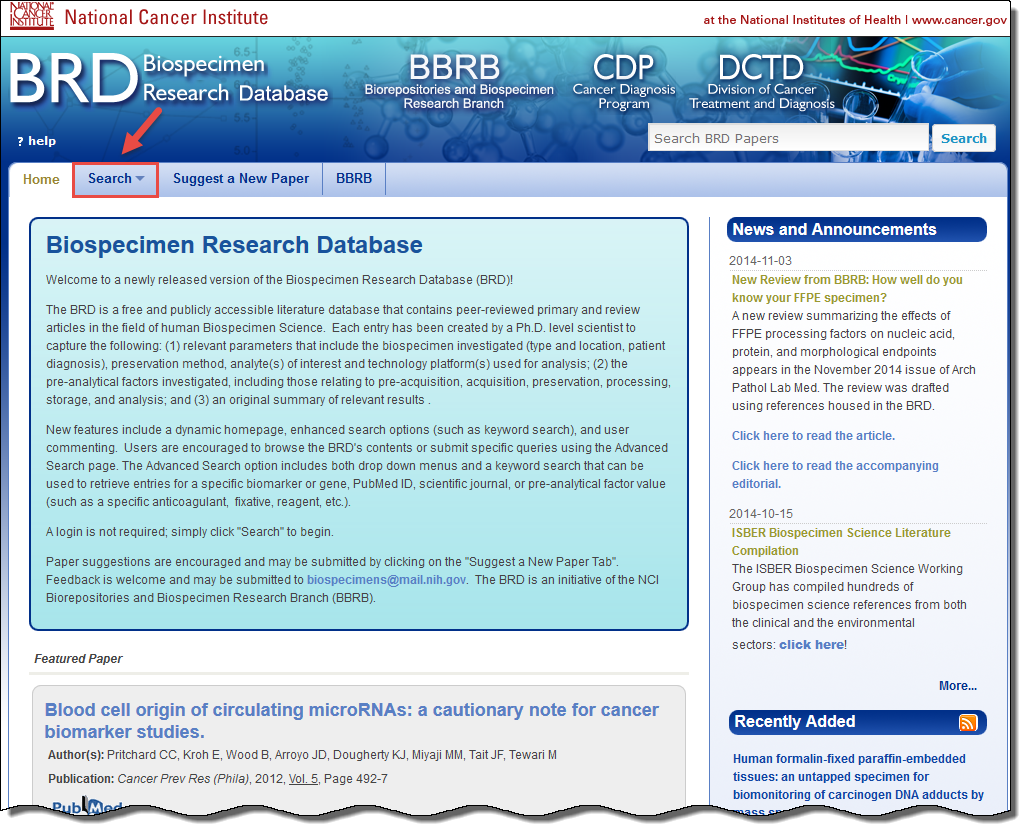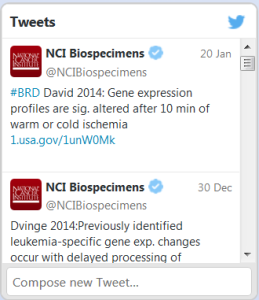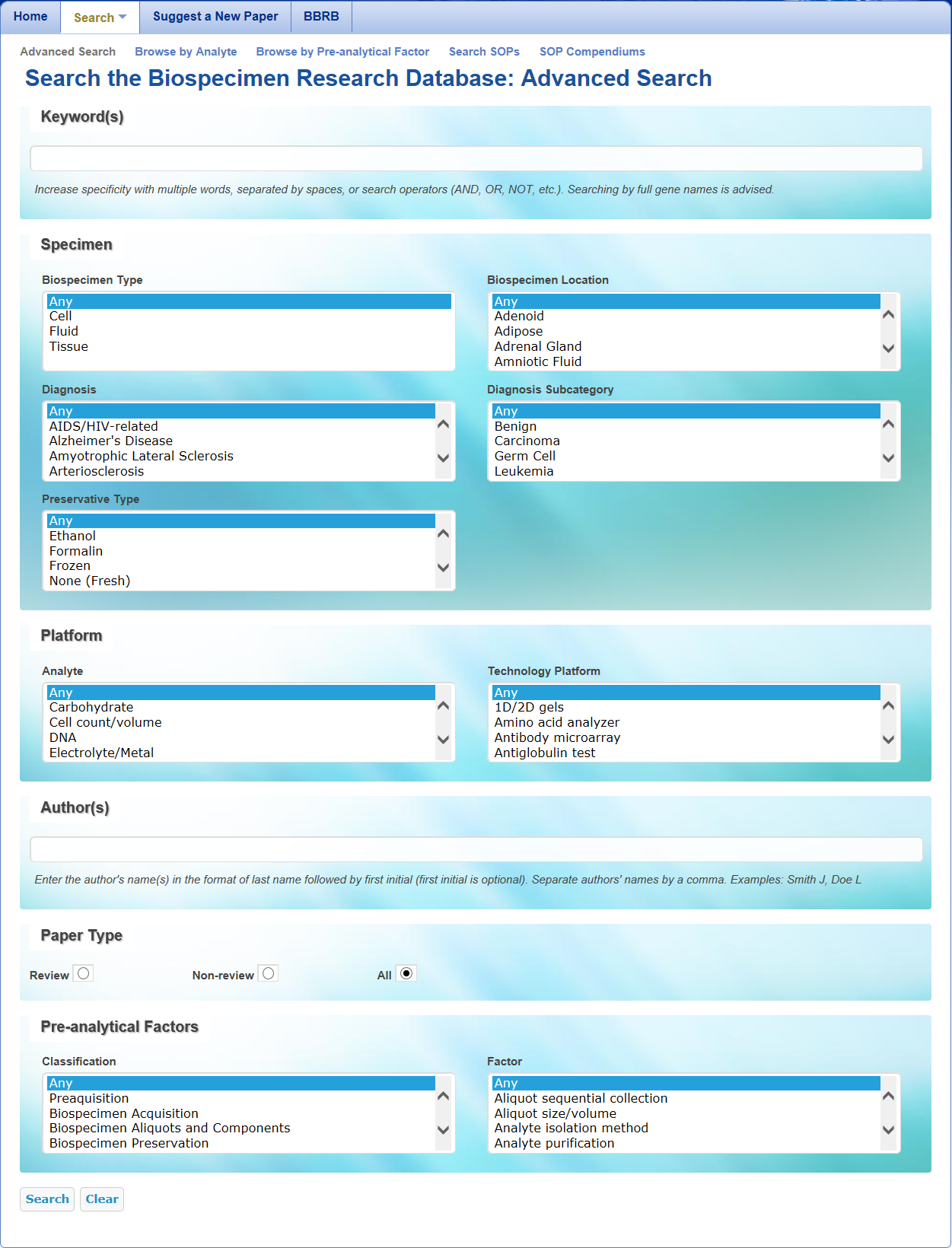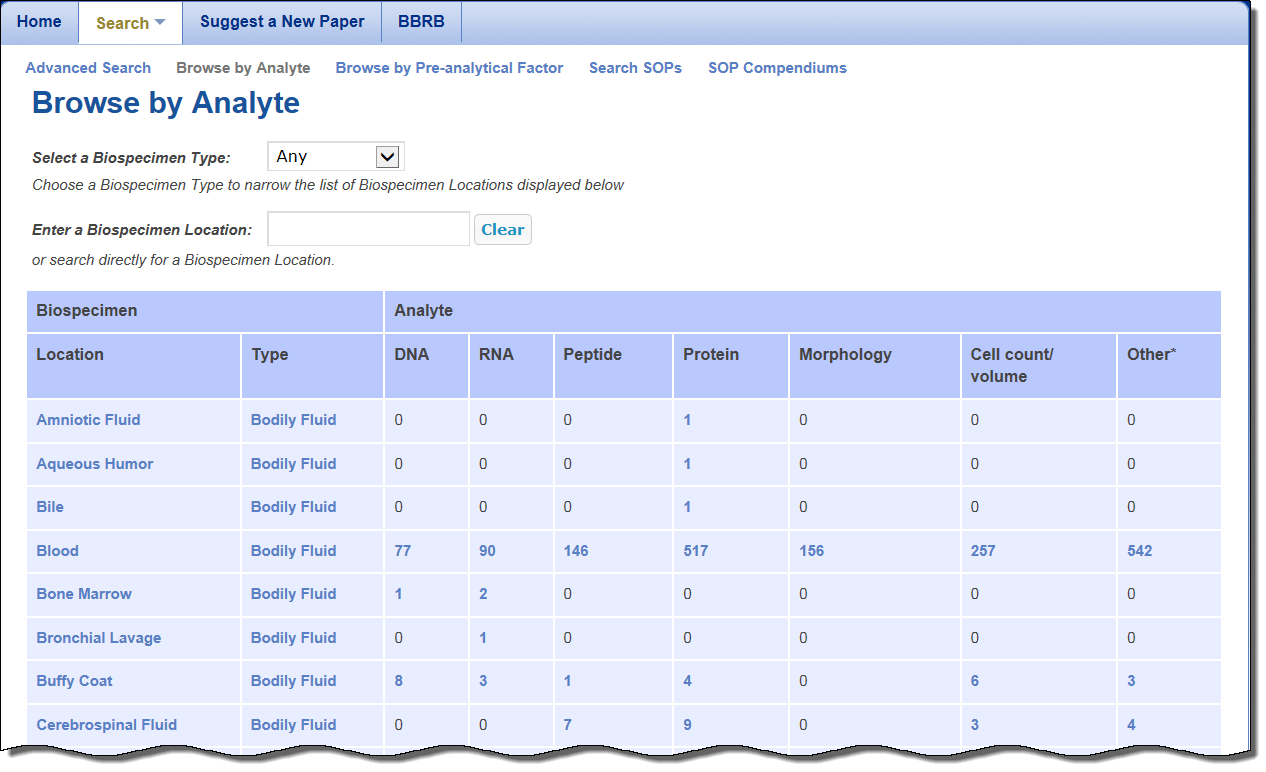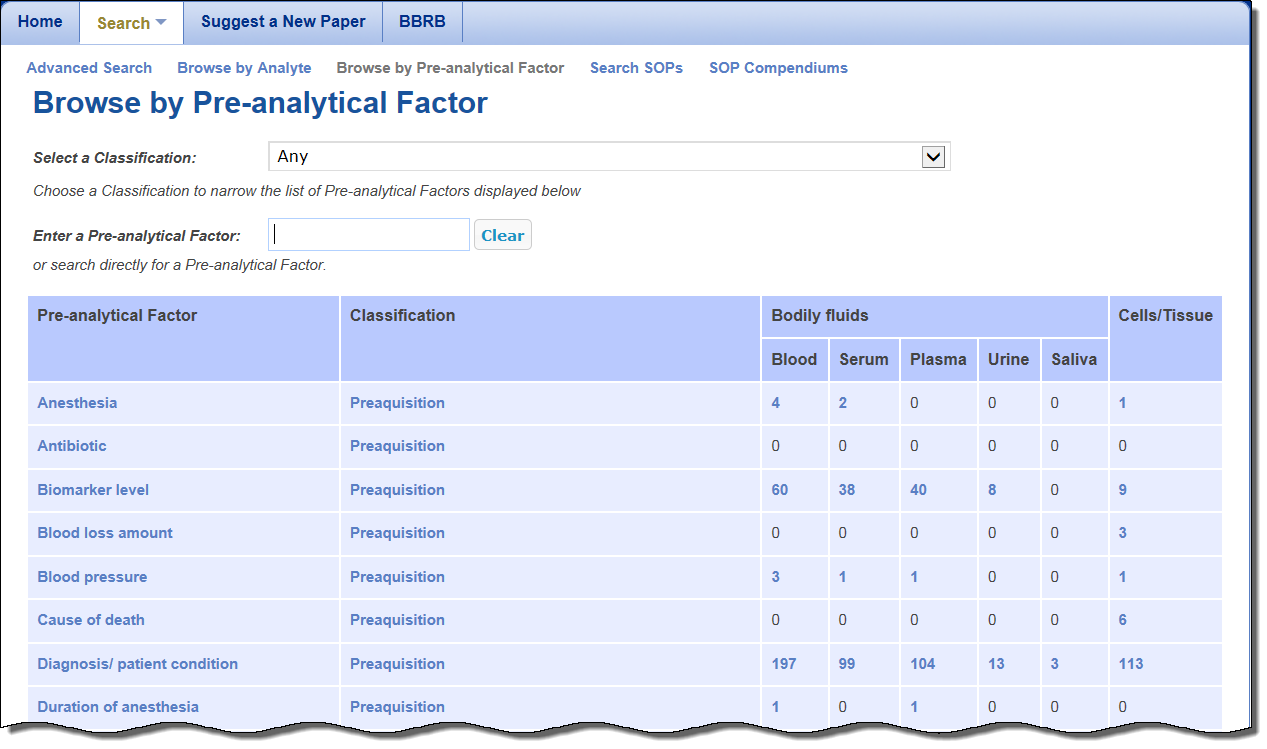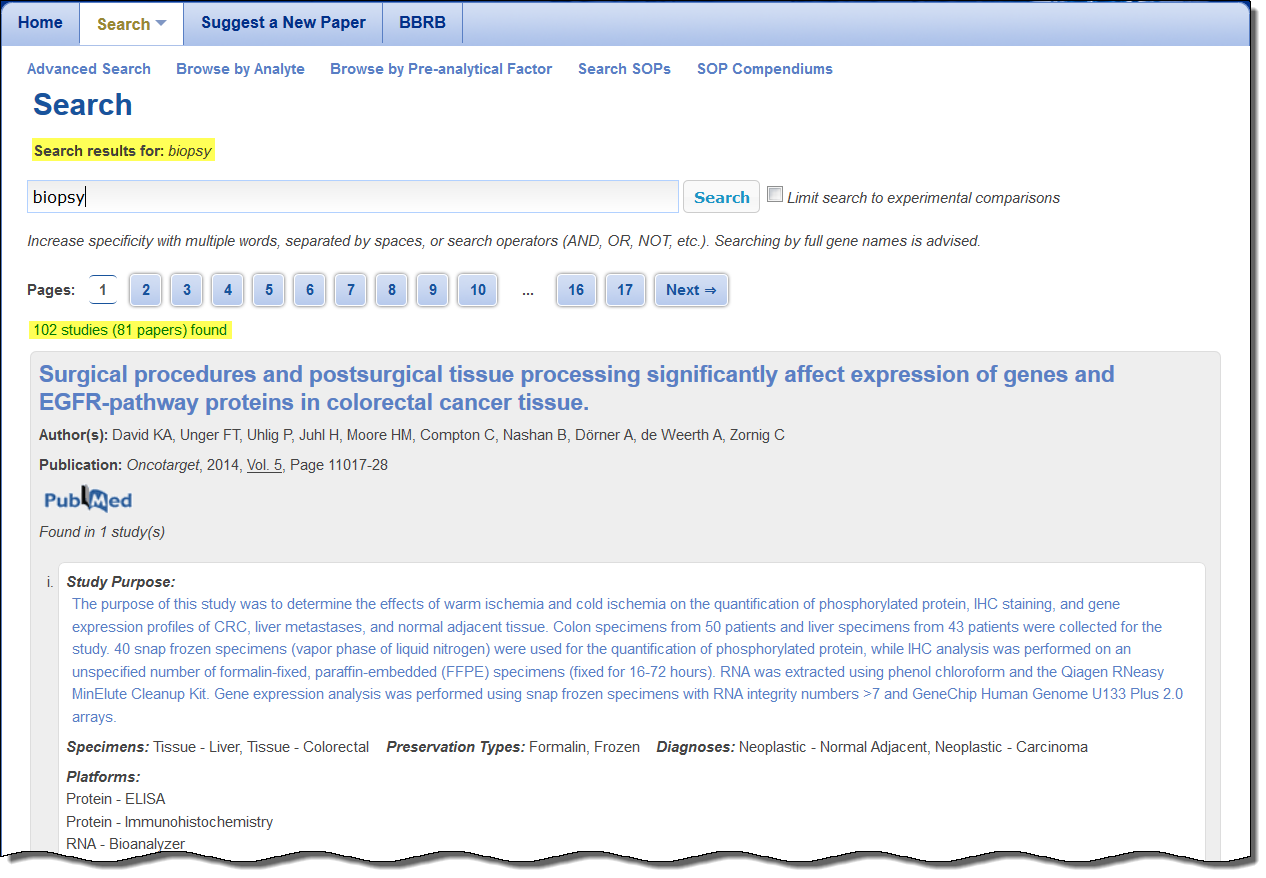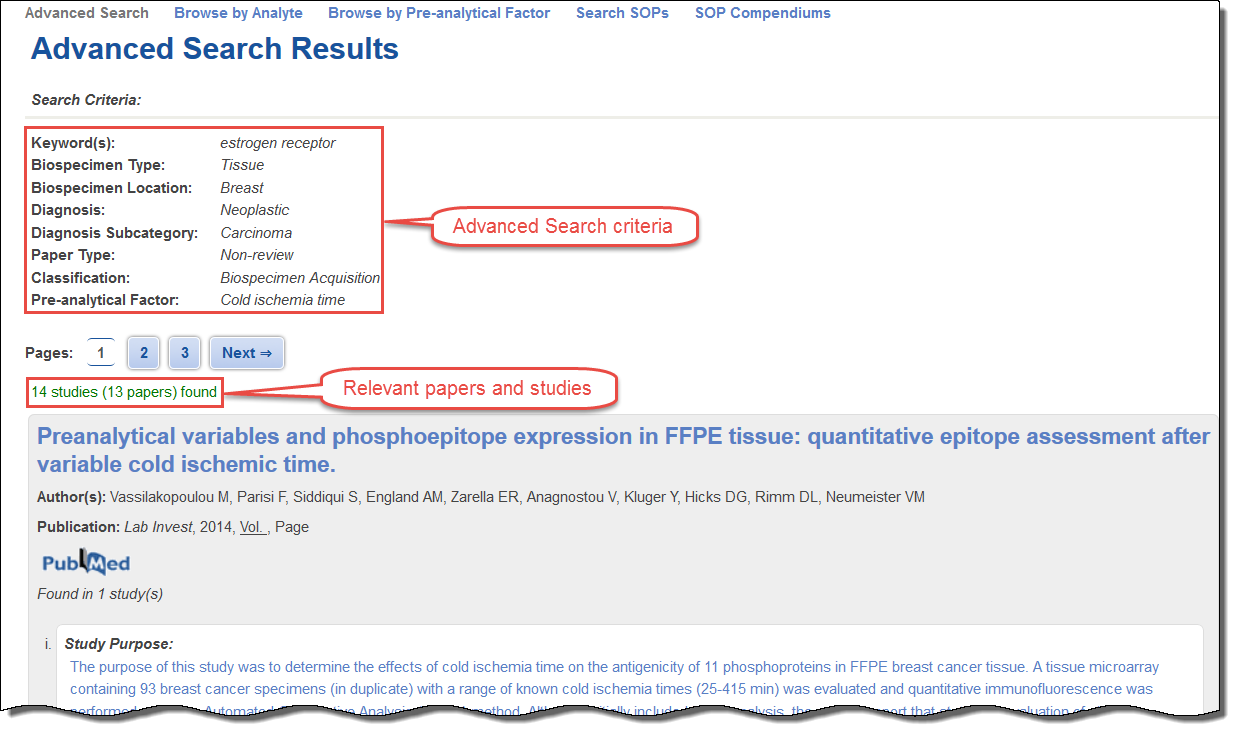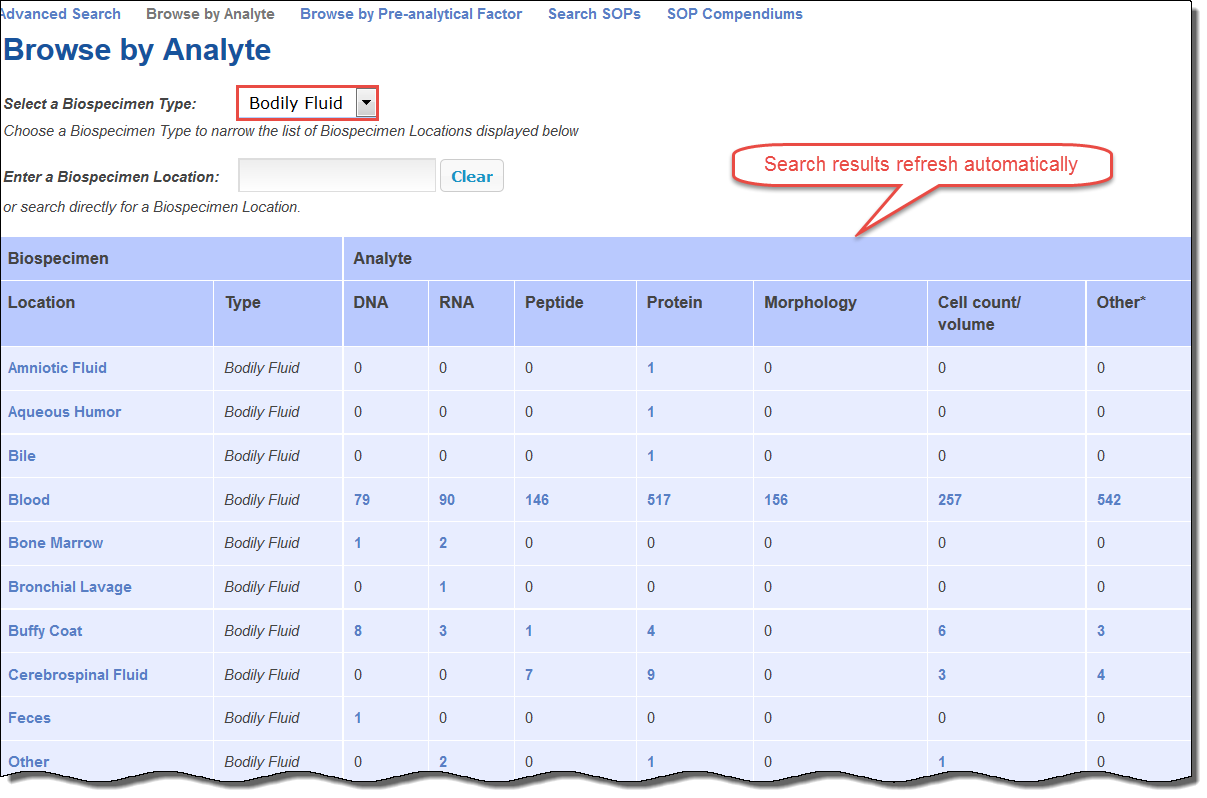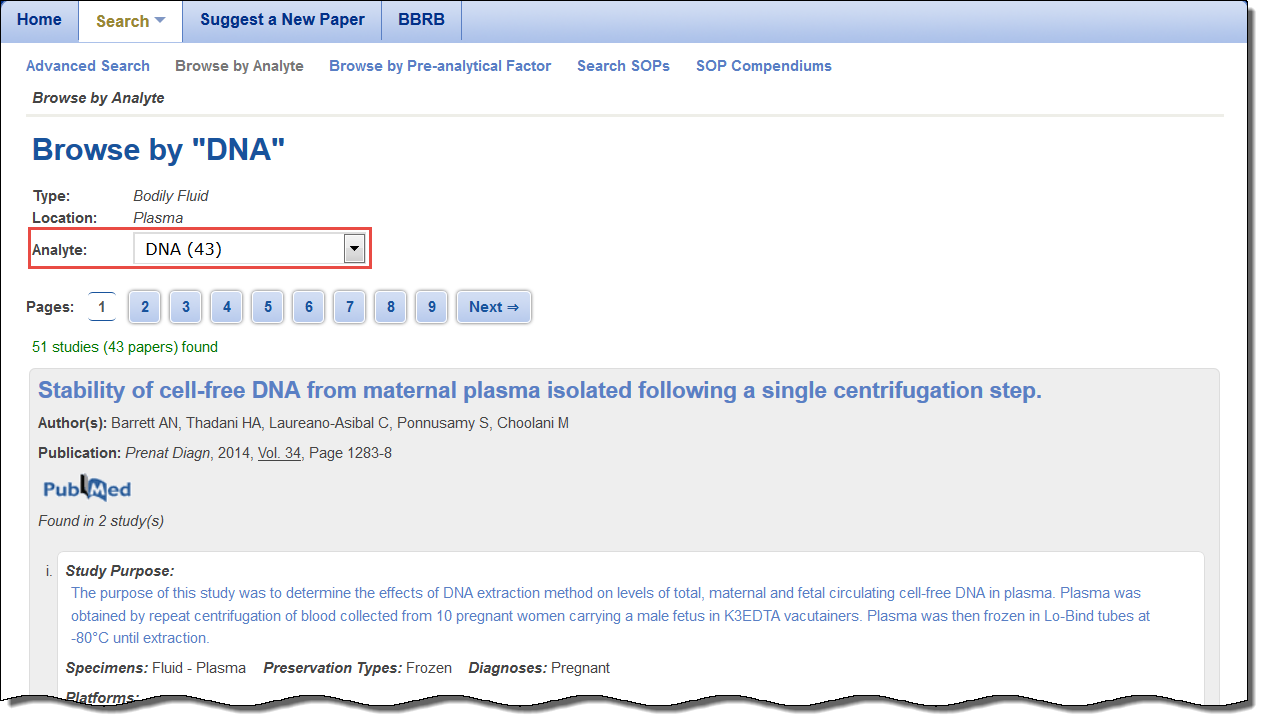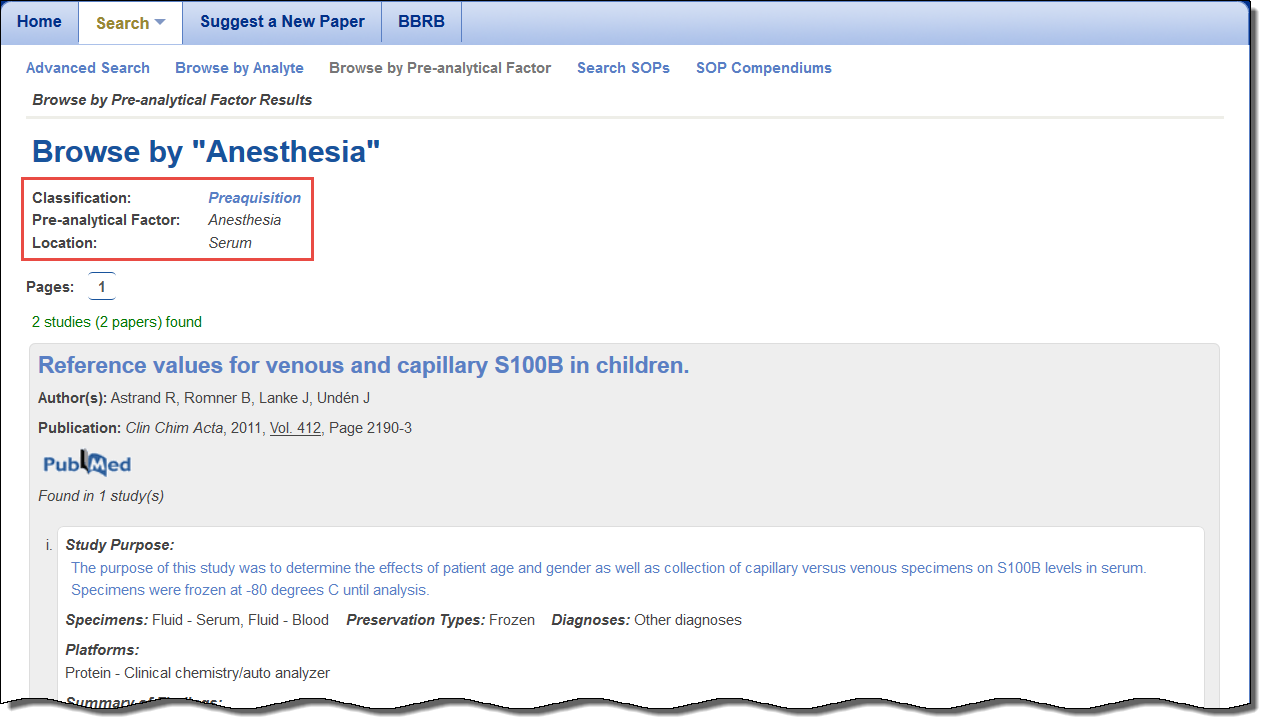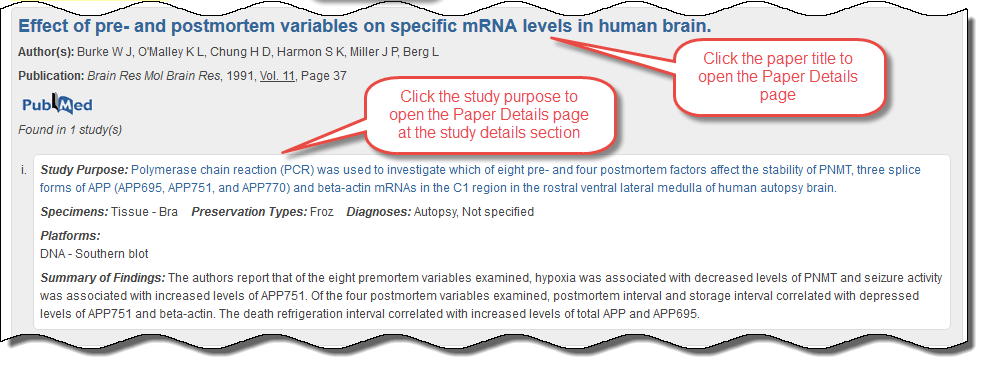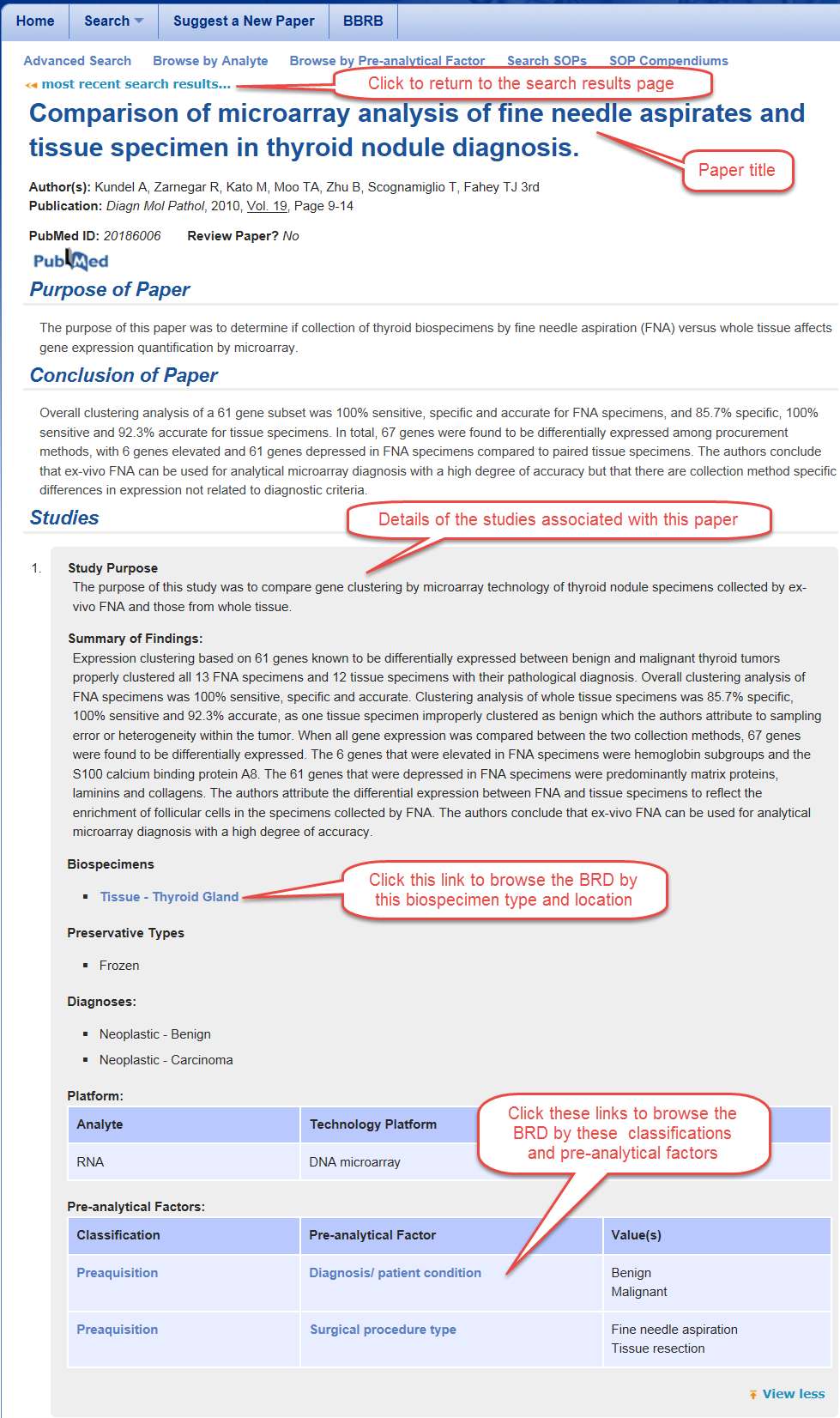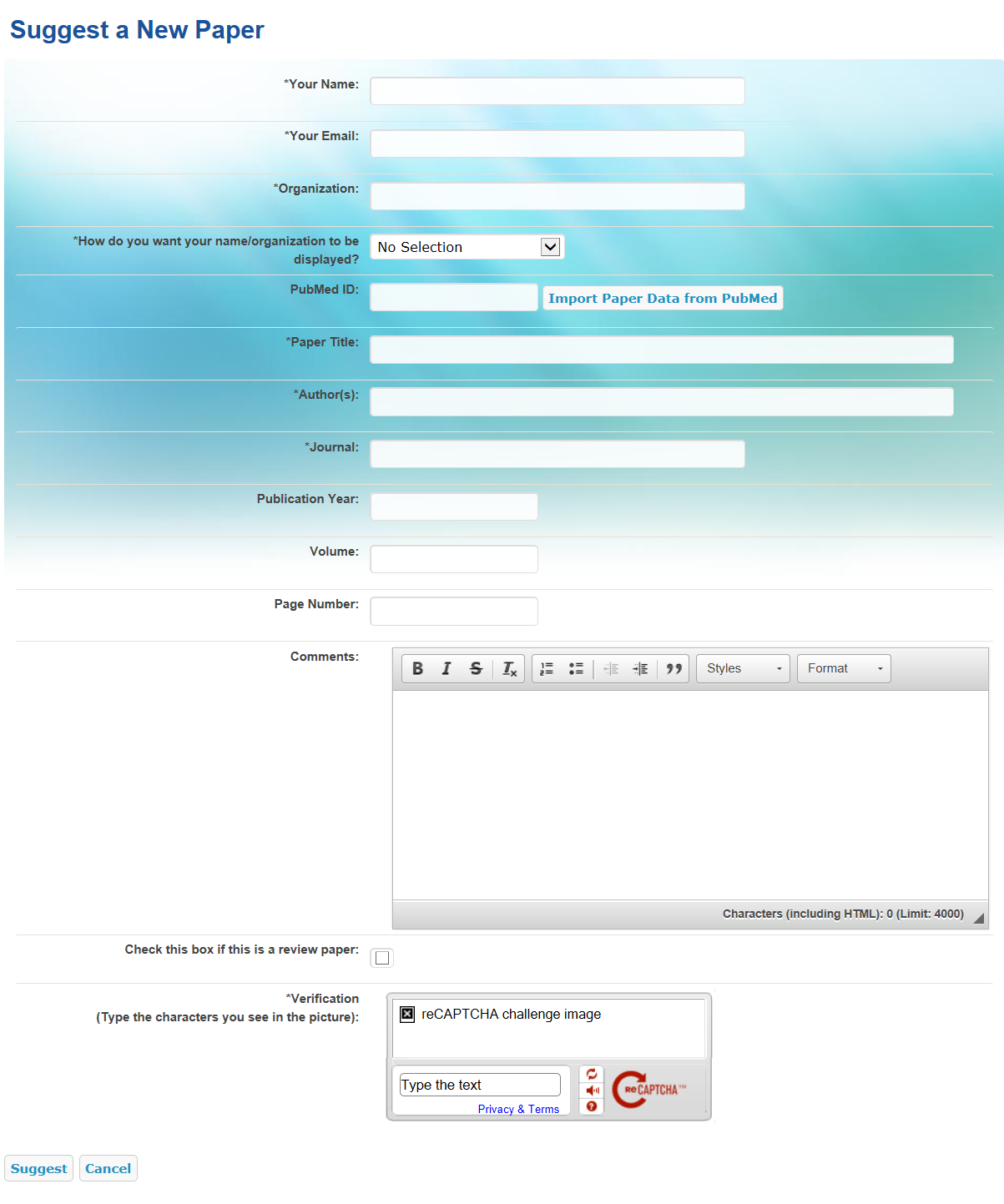This section introduces you to the procedures for searching the Biospecimen Research Database. It includes the following topics:
Search Overview
You can search the Biospecimen Research Database (BRD) to find research papers and studies that match criteria you specify. Each published paper is associated with one or more studies that address specific experimental questions. If you do not narrow your search by selecting search criteria, then all studies in the database will be returned as search results.
You can search the BRD in the following ways.
You do not need to log in or have an account to search the Biospecimen Research Database.
From the BRD home page, all search options appear when you click the Search tab.
The home page also contains a News and Announcements section, a Featured Paper identified by a BRD Curator, and lists of papers that have been added recently as well as those that were recently viewed by you. A Twitter feed from the NCI Biospecimens account is also displayed. If you want to share information on the BRD, compose a new tweet via your personal Twitter account using the #BRD hashtag.
Simple Search Overview
Located in the top right portion of the header on every BRD page, is a keyword search box labeled Search BRD Papers. You can search very quickly for any paper in the BRD by using any keyword including paper information, authors, free text, biospecimen location or type, or pre-analytical factor.
The Simple Search is highlighted in red in the screenshot below.
Advanced Search Overview
An Advanced Search includes all possible search criteria in a query format. This is the default search method. For more information, see Conducting an Advanced Search.
Browse by Analyte Overview
The Browse by Analyte search option displays the contents of the BRD in a table that is organized by both the analyte investigated and the biospecimen type and location used for analysis. The numbers within the table contain links to search results that correspond to the biospecimen type/location and analyte selected. From the Search Results page, you can toggle between results for other analytes for a given biospecimen type and location without the need to return to the Browse by Analyte page. For more information, see Browsing by Analyte.
Browse by Pre-analytical Factor Overview
The Browse by Pre-analytical Factor search option displays the contents of the BRD in a table that is organized by the experimental questions addressed (pre-analytical factor) and the biospecimen type/location used for analysis. Due to the large number of pre-analytical factors captured by the BRD, the table can be restricted by selecting a Classification or directly entering a pre-analytical factor. The number links in the table represent all of the relevant papers in the BRD for the corresponding pre-analytical factor listed in the row. For more information, see Conducting a Pre-analytical Factor Search.
Conducting a Simple Search
You can conduct a Simple Search for a paper from any BRD page. Enter any keyword associated with the area of interest (such as a tissue type, diagnosis, biomarker, fixative, anticoagulant, and so on) or a specific paper (such as the PubMed ID, title, journal, year, and so on). N ote that gene symbol use within the BRD is not standardized and it is recommended that you search using the full gene name. Also, if you are searching for a specific author, use the Author(s) search option on the Advanced Search page. Specificity can be increased by including multiple words with or without search operators. If using multiple search operators, use parentheses to control query logic. Search operators that are supported by Simple Search, example queries, and their anticipated results are summarized in the table below.
Simple Search Operators | Example | Results |
|---|---|---|
Double quotes (" ") will return curations that contain the exact phrase quoted. | "sodium heparin" | Curations containing the exact phrase sodium heparin |
Including AND or + between search phrases will return curations that contain both search phrases. If more than one search term is entered, this search operator will be applied as the default. | formalin AND paraffin or formalin + paraffin or formalin paraffin | Curations containing both formalin and paraffin |
| Including OR between search phrases will return curations that contain either search term. | frozen OR fresh | Curations containing either frozen or fresh |
Including NOT or - (minus) between search terms will return curations that do not contain the term that follows the operator. This operator must be used with a search term that will return results. | immunohistochemistry NOT "tissue microarray" | Curations containing immunohistochemistry but not tissue microarray |
An asterisk (*) is a wild-card search operator that can replace any number of characters in a search term. It can be used in the beginning, middle or end of a search term. | freeze-thaw cycl* | Curations containing either freeze-thaw cycle, freeze-thaw cycles, or freeze-thaw cycling |
A question mark (?) is a wild-card search operator that replaces a single character in the search term. It can be used in the beginning, middle or end of a search term. Multiple question marks can also be used within a single search term. | K?EDTA | Curations containing the term K2EDTA or K3EDTA |
A tilde (~) is a search operator that will return terms that are spelled similarly to the term that prefaces it. It should follow a single word search term. | anesthesia~ | Curations containing the terms anesthesia, anaesthesia, or anesthetized |
| Search operators can be used together and parentheses can be used to group queries. | circulating AND (microRNA OR miRNA) | Curations containing circulating and either microRNA or miRNA |
The proximity of two search terms to one another can be specified by placing the terms in quotations followed by a tilde (~) and the number of words allowable. | "circulating DNA"~2 | Curations containing circulating DNA, circulating cell free DNA or circulating cell-free DNA. |
| Prefacing a search phrase with pubMedId: will limit the query for the search phrase to the PubMed ID field. | pubMedId: 24486652 | A single curation with the PubMed ID 24486652 |
| Prefacing a search phrase with title: will limit the query for the search phrase to the Paper Title field. | title: hemoglobin | Curations that contain the word hemoglobin in the paper's title |
| Prefacing a search phrase with publicationName: will limit the query for the search phrase to the Journal of publication field. | publicationName: Biopreserv Biobank | Curations that were published in the journal Biopreserv Biobank |
| Prefacing a search phrase with curatorPurpose: will limit the query for the search phrase to the Purpose of Paper field. | curatorPurpose: "storage temperature" | Curations that contain the exact phrase storage temperature in the Purpose of Paper field. |
| Prefacing a search phrase with curatorConclusion: will limit the query for the search phrase to the Conclusion of Paper field. | curatorConclusion: clinically relevant | Curations that contain the words clinically and relevant in the Conclusion of Paper field. |
| Prefacing a search phrase with purpose: will limit the query for the search phrase to the Study Purpose field. | purpose: ischemia | Curations that contain ischemia in the Study Purpose field. |
| Prefacing a search phrase with summaryOfFindings: will limit the query for the search phrase to the study's Summary of Findings field. | summaryOfFindings: statistically significant | Curations that contain the words statistically and significant in the Summary of Findings field. |
To conduct a Simple Search
- At the top of any BRD page, find the Search BRD Papers box.
- Enter text relevant to a specific paper or your area of interest into the box. You can enter any keyword or multiple keywords separated by a space.
- Press Enter or click Search. The search results page appears.
- To make your search more specific, you may opt to select the Limit search to experimental comparisons box. This limits the search fields to Pre-analytical Factors and their values. For example, if you entered the term biopsy as a keyword and you limited your search to experimental comparisons, the search results would immediately refresh to show you only those papers in which biopsy was compared to other biospecimen procurement methods.
Conducting an Advanced Search
An Advanced Search of the Biospecimen Research Database provides you with the most control over search criteria and results in comparison to other search options.
When specifying search criteria in the Biospecimen Research Database, there are no required fields. You can add as much detail or only those criteria that you consider essential to the search. You can also select multiple search terms in the same list by selecting the first item, pressing and holding Ctrl, and then selecting the next item(s).
If you don't specify any criteria, all entries in the BRD appear in the search results.
If a paper you are looking for is not in the BRD, you can suggest a new paper.
To conduct an Advanced Search
- Click Advanced Search, which is located under the Search tab. The Advanced Search page appears.
- For maximum search accuracy, specify search criteria by clicking items in the lists.
- To select multiple fields in the same list, click the first field, press and hold the CTRL key, and then click additional fields. The fields you select are highlighted and your search results contain all studies matching any of the fields. For example, if you select both the Cell and Fluid biospecimen types, your search results contain all studies that concern either cells or fluid.
When you select fields from different lists, you narrow your search. For example, if you select the Cell biospecimen type and the Kidney biospecimen location, your search results include studies that concern both cells and kidneys.
Note that the selections you make in the lists on the left determine the selections in the lists on the right. For example, selecting the Biospecimen Type “Fluid” makes “Blood” an available Biospecimen Location.
The following table describes the Advanced Search criteria.
Advanced Search Criteria
Description
Specimen
Biospecimen Type
Select the type of biospecimen (Tissue/Fluid/Cell).
Biospecimen Location
Select the bodily location from which the biospecimen was obtained.
Diagnosis
Select the term that identifies the nature of a disease or condition associated with the biospecimen.
Diagnosis Subcategory
Select the diagnosis subdivision that differentiates the disease within the larger category.
Diagnosis Subcategory is only available for the diagnosis "neoplastic.”
Preservative Type
Select the substances added to the biospecimen, or other treatment to protect it from chemical change or microbial action.
Platform
Analyte
Select the analyte, or endpoint that was qualitatively or quantitatively examined in the biospecimen. Select "Morphology" for macro- and microscopic analysis.
Technology Platform
Select the specific technology used to analyze the biospecimen.
Author(s)
Enter the author’s name(s) in the format of last name followed by first initial (first initial is optional). Separate authors' names by a comma. Use " * " as wildcard. Examples: Smith J, Doe L
If an author's name has a special character in it, be sure to include that special character in your keyword search. You can only use special characters included in the UTF-8 character set.
Paper Type
Select among the paper type options: Review, Non-review, or All. If you do not select any search criteria prior to clicking the Search button, the search uses Paper Type: All as its default search criterion.
Pre-analytical Factors
Classification
The type of biospecimen handling variable that was the subject of the study (pre-acquisition, post-acquisition, or platform specific)
Factor
The specific pre-analytical factor that was the subject of the study (e.g., the post-acquisition variable, "type of fixative," is a specific pre-analytical factor in a study that examines the effects of different types of tissue fixatives on molecular analysis).
If you want to search for items not present in the drop-down lists such as specific genes or biomarkers, enter those items in the Keyword box. Multiple words can be entered with or without a search operator to increase specificity. See Conduct a Simple Search for a list of supported search operators. This search method searches all fields including paper information, authors, summary fields, and Pre-analytical Factors and their values. The keyword search can be used together with other fields on the Advanced Search page.
Gene symbol use is not standardized, so search by the full gene name.
- Click the Search button. Studies in the BRD that match your search criteria appear.
- Page through the results or click any blue link to see study details.
On the search results page, you can:
- View a summary of all of the studies matching your search criteria.
- Click the paper title hyperlink to view detailed information about the paper.
Click the Study Purpose hyperlink to view detailed information about the study.
Show and Hide Study Details
Paper and study details are both on the Paper Details page. Click View More or View Less to show or hide the study details.
- Click to view that paper’s listing in PubMed in a new browser window.
- Click most recent search results link at the top left of the page to return to the search page and search criteria you last used.
- Comment on the paper or study listed on the page by registering with Disqus or logging in with a social media account.
Browsing by Analyte
When you browse the BRD by analyte, you can navigate between analytes for a given biospecimen location by clicking a number link in the table.
If a paper you are looking for appears to be missing, first run an Advanced Search and then consider suggesting a new paper.
To browse by analyte
Click Browse by Analyte, which is located under the Search tab. The Browse by Analyte page appears, displaying all of the papers in the BRD within a table that is organized by biospecimen type and location and analyte(s) investigated.
- To search the database, do one of the following
- If you only want to see results of one biospecimen type, choose it from the Select a Biospecimen Type list. The table immediately refreshes to show only those biospecimen locations and results for that biospecimen type. Specifying this filter option narrows your search.
- If you want to search directly for one biospecimen location, type it into the Enter a Biospecimen Location box. The table immediately refreshes to show only those results for that biospecimen location. Specifying this filter option narrows your search.
Click a number link as explained in the following table.
Click a link in the... To see... Biospecimen columns all research studies in the database that involve that biospecimen location or type Analyte columns all research studies in the database that involve that analyte Body of the table all research studies in the database that involve the unique combination of biospecimen location, biospecimen type, and analyte in that table row.
The numerical link corresponds to the number of research papers that fulfill the search criteria combination.The numerical links do not add up to the total number of papers in the database. Each cell represents only the number of papers that meet the specified search criteria in this table. Many other search criteria can be accessed by conducting an Advanced Search.
Studies that match of the criteria you selected appear in the table.
- Click a link in the table, either a biospecimen location or a number. Note that in the screenshot above, the biospecimen type is not selectable because the previous search resulted in showing only those papers involving one biospecimen type.
The studies matching your selection appear. Note that your search criteria appear above the list of papers and studies.
- Page through the results or click any blue link to see study details. Note that you can filter your results by selecting an analyte from the Analyte list.
On the search results page, you can:
- View a summary of all of the studies matching your search criteria.
- Click the paper title hyperlink to view detailed information about the paper.
Click the Study Purpose hyperlink to view detailed information about the study.
Show and Hide Study Details
Paper and study details are both on the Paper Details page. Click View More or View Less to show or hide the study details.
- Click to view that paper’s listing in PubMed in a new browser window.
- Click the most recent search results link at the top left of the page to return to the search page and search criteria you last used.
- Comment on the paper listed on the page by registering with Disqus or logging in with a social media account.
Browsing by Pre-analytical Factor
Browsing by Pre-analytical Factor allows you to find research studies corresponding to selected Pre-analytical Factors.
If you are not able to find a specific paper, first run an Advanced Search and then consider suggesting a new paper.
To browse by Pre-analytical Factor
- Click Browse by Pre-analytical Factor, which is located under the Search tab. The Browse by Pre-analytical Factor page appears.
- To search the database, do one of the following
- If you only want to see results of one Classification, select it from the first list. The table immediately refreshes to show only Pre-analytical Factors assigned to that classification and results for each of those Pre-analytical Factors. Note that selecting an option here narrows your search and gives you fewer results.
- If you only want to search directly for one Pre-analytical Factor, enter that term or factor in the text box. The table immediately refreshes to show results only for that term or Pre-analytical Factor. Note that all Classifications will be screened for the term or factor. Also, selecting an option here also narrows your search and gives you fewer results.
Click a number link as explained in the following table.
Click a link in the... To see... Pre-analytical Factor column all research papers and studies in the database that involve that Pre-analytical Factor Classification column all research papers and studies in the database that involve that Classification Body of the table all research papers and studies in the database that involve a unique combination of Pre-analytical Factor, Classification, and either bodily fluid or cells/tissue in that table row. The numerical link corresponds to the number of papers that fulfill the search criteria combination.
The numerical links do not add up to the total number of papers in the database. Each cell represents only the number of papers that meet the specified search criteria in this table. Many other search criteria can be accessed by conducting an Advanced Search.
Studies that match of the criteria you selected appear. Note that your search criteria appear above the list of papers and studies.
- Page through the results or click any blue link to see paper or study details.
On the search results page, you can:
- View a summary of all of the studies matching your search criteria.
- Click the paper title hyperlink to view detailed information about the paper.
Click the Study Purpose hyperlink to view detailed information about the study.
Show and Hide Study Details
Paper and study details are both on the Paper Details page. Click View More or View Less to show or hide the study details.
- Click to view that paper’s listing in PubMed in a new browser window.
- Click the most recent search results link at the top left of the page to return to the search results page and search criteria you last used.
- Comment on the paper listed on the page by registering with Disqus or logging in with a social media account.
Viewing Paper and Study Details
Once you have searched the database and are viewing your results, click the paper title to open the Paper Details page, where you can view a paper’s entire record. Click the Study Purpose and open the Paper Details page at the section for that study's details.
Each paper includes one or more associated studies. Studies are defined as the set(s) of experiments within a paper that investigate different pre-analytical factors, use different analytical platforms for analysis, or explore different biospecimen sample sets. For example, a paper that examines the effect of a biospecimen handling variable on RNA and protein analysis may have two studies in the database, one study describing the results of RNA analysis and one describing the results of protein mass spectroscopy analysis.
On the Paper Details page, you can:
- View complete bibliographic information about the paper.
- View whether the paper is a Review or Nonreview paper.
- Click to view that paper’s listing in PubMed in a new browser window.
- View the paper's purpose and conclusion.
- View a summary of the paper's associated studies.
- Click the View More link at the bottom of the page to view additional study details.
You can also choose to expand the page to view all of the study details, including:
- Study Purpose
- Information about biospecimen type and location
- Analyte studied
- Platform used
- Pre-analytical Factors
- Study Findings
You can search the BRD for related studies with the same biospecimen type and location, classification(s), and pre-analytical factor(s) by clicking the links in the study details.
To return to your search results, click most recent search results... at the top of the page.
Commenting on a Paper
Add a comment to a paper to share your thoughts with others using the BRD. Before you can comment, you must either register with Disqus or log in with your Facebook, Twitter, or Google account. All comments are subject to moderation by the BRD Curation Team.
To add a comment to a paper
- Scroll to the bottom of the Paper Details page to the comment box.
Click the arrow next to the Login menu and select the method by which you would like to log in: Disqus, Facebook, Twitter, or Google.
- Follow the prompts to either create and log in with a Disqus account, log in with an existing Disqus account, or log in with a social media account. If you choose a social media account, you merge that account with Disqus and can log in with those credentials each time you want to comment.
- In the comment box, enter your comment. If you have not yet logged in, the application prompts you to log in using one of the methods in the previous step.
- Click Post to complete the comment.
- Optionally, sort the comments, share them on social media, and make the paper a favorite.
To sort the comments, select one of the following options from the Sort by list:
- Best - Comments with the most votes trending over time.
- Newest - Most recent comments first.
- Oldest - Oldest comments first.
To share the comment, click Share and then click either the Twitter or the Facebook icon.
To make the paper a favorite, click the star icon next to Favorite.
For more information about using Disqus, see the Disqus Knowledge Base.
Suggesting a New Paper
If you know of a paper that would be a useful addition to the Biospecimen Research Database, you can suggest it. Paper suggestions are screened against BRD contents to prevent duplication. Curators will review each suggestion and add BRD-appropriate papers to the database.
If you include your email address you will receive an update when your paper suggestion has been added.
To suggest a new paper
- Click the Suggest a New Paper tab. The Suggest a New Paper page appears.
- Enter the following required fields about yourself: your name, email address, and organization.
- In the How do you want your name and organization to be displayed list, specify your acknowledgement preference.
- If the paper is indexed for PubMed, enter the PubMed ID in the PubMed ID field and click Import Paper Data from PubMed. This populates all of the required bibliographic fields.
- If the paper is not in PubMed, enter the following required information about the paper in the relevant fields: paper title, author(s), and journal name.
- Optionally, enter the publication year, volume, page number, and comments about your suggestion in the relevant fields.
- If the paper is a review paper, check the box.
- In the Verification area, enter the characters exactly as you see them. If you cannot see the characters you can click the refresh icon to obtain a new set of characters.
- Click Suggest.
Citing the BRD
We encourage you to cite the Biospecimen Research Database (BRD) when utilizing the resource to develop written materials including articles and SOPs. When citing the BRD as a resource, we recommend you include the most recent access date as well as the following information:
| Database Title: | Biospecimen Research Database |
| Type of Medium: | Internet |
| Place of Publication: | Bethesda, MD |
| Publisher: | Biorepositories and Biospecimen Research Branch, National Cancer Institute |
| Availability: | http://biospecimens.cancer.gov/brd |
An example using the citation style provided by the National Library of Medicine in Citing Medicine: The NLM Style Guide for Authors, Editors, and Publishers, 2nd edition is below.
Biospecimen Research Database [Internet]. Bethesda (MD): National Cancer Institute, Biorepositories and Biospecimen Research Branch; [cited 2015 Mar 10]. Available from http://biospecimens.cancer.gov/brd

